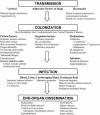Clinical microbiology of bacterial and fungal sepsis in very-low-birth-weight infants
- PMID: 15258097
- PMCID: PMC452555
- DOI: 10.1128/CMR.17.3.638-680.2004
Clinical microbiology of bacterial and fungal sepsis in very-low-birth-weight infants
Abstract
Twenty percent of very-low-birth-weight (<1500 g) preterm infants experience a serious systemic infection, and despite advances in neonatal intensive care and antimicrobials, mortality is as much as threefold higher for these infants who develop sepsis than their counterparts without sepsis during their hospitalization. Outcomes may be improved by preventative strategies, earlier and accurate diagnosis, and adjunct therapies to combat infection and protect the vulnerable preterm infant during an infection. Earlier diagnosis on the basis of factors such as abnormal heart rate characteristics may offer the ability to initiate treatment prior to the onset of clinical symptoms. Molecular and adjunctive diagnostics may also aid in diagnosing invasive infection when clinical symptoms indicate infection but no organisms are isolated in culture. Due to the high morbidity and mortality, preventative and adjunctive therapies are needed. Prophylaxis has been effective in preventing early-onset group B streptococcal sepsis and late-onset Candida sepsis. Future research in prophylaxis using active and passive immunization strategies offers prevention without the risk of resistance to antimicrobials. Identification of the differences in neonatal intensive care units with low and high infection rates and implementation of infection control measures remain paramount in each neonatal intensive care unit caring for preterm infants.
Figures


References
-
- Reference deleted.
-
- Reference deleted.
-
- Reference deleted.
-
- Reference deleted.
-
- Reference deleted.
Publication types
MeSH terms
LinkOut - more resources
Full Text Sources
Other Literature Sources
Medical

